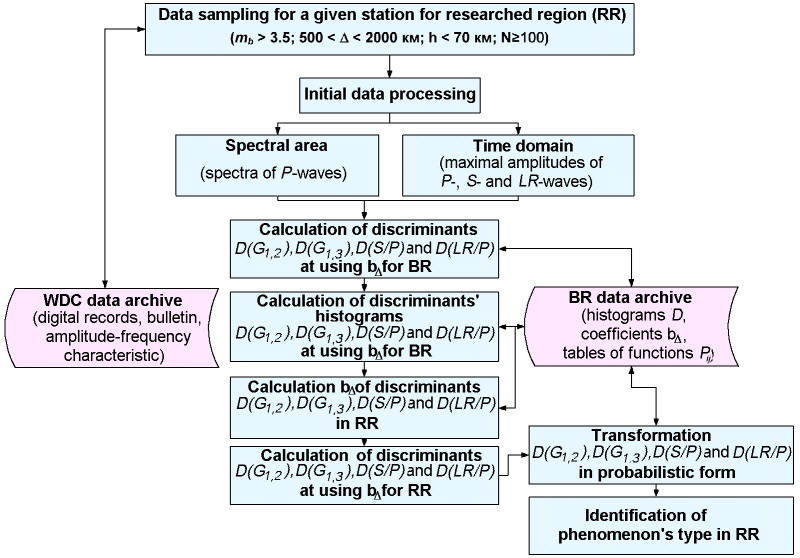
RUSSIAN JOURNAL OF EARTH SCIENCES VOL. 11, RE3007, doi:10.2205/2009ES000433, 2010
Automatization of procedures of initial processing of seismic signals at calibrating directions source-station
O. K. Kedrov1, E. O. Kedrov2, N. A. Sergeeva2, A. B. Chulkov3, L. P. Zabarinskaya2
1Schmidt Institute of Physics of the Earth RAS, Moscow, Russia
2Geophysical Center RAS, Moscow, Russia
3ZAO "Integral", Moscow, Russia
Extended Abstract
The Method of Dynamic Calibration (MDC) of stations of the
International System of Seismic Monitoring (ISM) was developed
for calibrating regions, where no underground nuclear
explosions were carried out, with the purpose of providing
conditions for implementation of the Comprehensive Nuclear
Test-Ban Treaty (CNTBT) in non-calibrated regions of the globe
[Kedrov, 2001; Kedrov and Luke, 2001; Kedrov and Kedrov, 2003]. The essence of MDC relates to adapting diagnostic parameters of
identification of underground nuclear explosions (UNE) and
earthquakes, elaborated for the region of Eurasia, taken as a
Basic region [Kedrov et al., 1990; Kedrov and Luke, 1999], for other researched regions (RR), which
differ from BR in the character of attenuation of seismic
waves. The testing results of "Kalibr" research program, realizing the
MDC algorithm, were obtained according to the experimental data
from Central Asia and represented in the work [Kedrov et al., 2008]. The unique character of MDC lies in the fact that calibration
of diagnostic parameters of identification of UNE and
earthquakes at source-station routes was implemented by this
method using only natural seismicity data within the limits of
an explored region and doesn't require special underground
chemical calibration explosions. In the program "Kalibr" two diagnostic parameters are used,
characterizing seismic signals in temporal area (Xi): ratios of
maximal amplitudes (Amax) in wave-train of traversal S and
longitudinal waves P: S/P, and also – of surface
LR and longitudinal wave-trains P: LR/P, and two – in frequency
area (Gi): ratios of sums (Si) of spectral amplitudes of
longitudinal waves in three frequency bands: S1(0.3-0.6 Hz),
S2(1.3-3.0 Hz) and S3(3.0-6.0 Hz): S1/S2 and S1/S3. Diagnostic parameters, not dependent on the influence of magnitude mb of
event and epicenter distance Δ (in km), i.e. discriminants Di,
characterizing only a type of event (UNE and earthquake) look
as:
D(S/P) = log (S/P) – bΔ log Δ,
(1)
D(LR/P) = log (LR/P) – am mb + bΔ log Δ,
(2)
D(G1,2) = log S1 – am1 mb – logS2 + am2 mb – bΔ log Δ,
(3)
D(G1,3) = log S1 – am1 mb – logS3 + am3 mb – bΔ log Δ,
(4)
where am, am1, am2, am3 and bΔ – regression coefficients, evaluated for the Basic region according to the records of UNE and earthquakes at Borovoye station (BRVK, Kazakhstan) separately for two zones of distances: (1) 0.5–1.5 ths km and (2) 1.5–4.0 ths km taking into account characteristic parameters of amplitudes' attenuation of seismic waves P, S and LR at a distance from an event's epicenter.
In the present version of "Kalibr" program (see Figure 1), initial processing of seismic signals was done in interactive regime, that significantly delayed calibration of a separate source – station route.

| Figure 1. Scheme of algorithm of seismic data processing for dynamic calibration of ISM stations and identification of phenomena in nuclear tests-free regions. |
The purpose of the present work was the development of algorithms and "Spektr" and "Signal" research programs, allowing to automate the process of measuring signals' seismic parameters in large data sampling, used in "Kalibr" program thus settling down the above-mentioned problem.
Quality evaluation of seismic signals' parameters, obtained automatically by "Spektr" and "Signal" research programs, was carried out on the basis of comparing with the results of data processing in interactive regime using "MSEISMO" program system [Kedrov et al., 1989] and "Seismologist's workplace" ("SWP") programs, which were at the authors' disposal.
Testing of MDC using the developed algorithms and programs of initial processing of signals was carried out according to the records of earthquakes, registered at Makanchi station (MKAR) in Kazakhstan from the area of the Lobnor training ground in China and at Pandale station (PDAR) in the US from the neighboring area to Nevada training ground.
References
Kedrov O. K. (2001), Method of Seismological Calibration of the International Monitoring System Using Regional Discriminants, Doklady RAN, 380, 390–395.
Kedrov O. K., E. I. Luke et al. (2001), Study of Influence of Distribution of Seismic Signals on Efficiency of Identification of Underground Nuclear Explosions and Earthquakes at Regional Distances, Fizika Zemli, No. 7, 32–57.
Kedrov O. K., E. O. Kedrov (2003), Identification of Seismic Phenomena at "Talgar" station Taking into Account Source-Station Route, Fizika Zemli, No. 12, 14–22.
Kedrov O. K., V. A. An, V. A. Laushkin et al. (1990), Methods of Underground Nuclear Explosions' Monitoring by Seismic Data at Epicenter Distances over 500 kilometers, Fizika Zemli, No. 12, 31–46.
Kedrov O. K., E. I. Luke (1999), Recognition of Nuclear Explosions and Earthquakes in Eurasia by Seismic Data at Regional Distances, Fizika Zemli, No. 9, 52–75.
Kedrov O. K., E. O. Kedrov, N. A. Sergeeva et al. (2008), Application of Dynamic Calibration Method for ISM Stations in Central Asia by Natural Seismicity Data, Fizika Zemli, No. 5, 16–33.
Kedrov O. K., A. I. Nemytov et al. (1989), Method and Program Realization of Automatic Detection and Localization of Seismic Phenomena at Three-Component Station in Real-time Regime, Doklady AN USSR, 307(1), 67–73.
Received 11 November 2009; accepted 3 December 2009; published 29 January 2010.
Keywords: international monitoring system, earthquake, spectra, calibration, diagnostic parameter

Citation: (2010), Automatization of procedures of initial processing of seismic signals at calibrating directions source-station, Russ. J. Earth Sci., 11, RE3007, doi:10.2205/2009ES000433.
Copyright 2010 by the Russian Journal of Earth Sciences